Yoruba gods and goddesses: their history explained in detail
Yoruba Gods and Goddesses mesmerize ordinary people and scientists. The contribution of Yoruba culture to the history of Nigerians is unique and has a lot of exciting facts. Keep reading to get acquainted with Yoruba mythology, the most mysterious phenomenon of Yoruba culture.
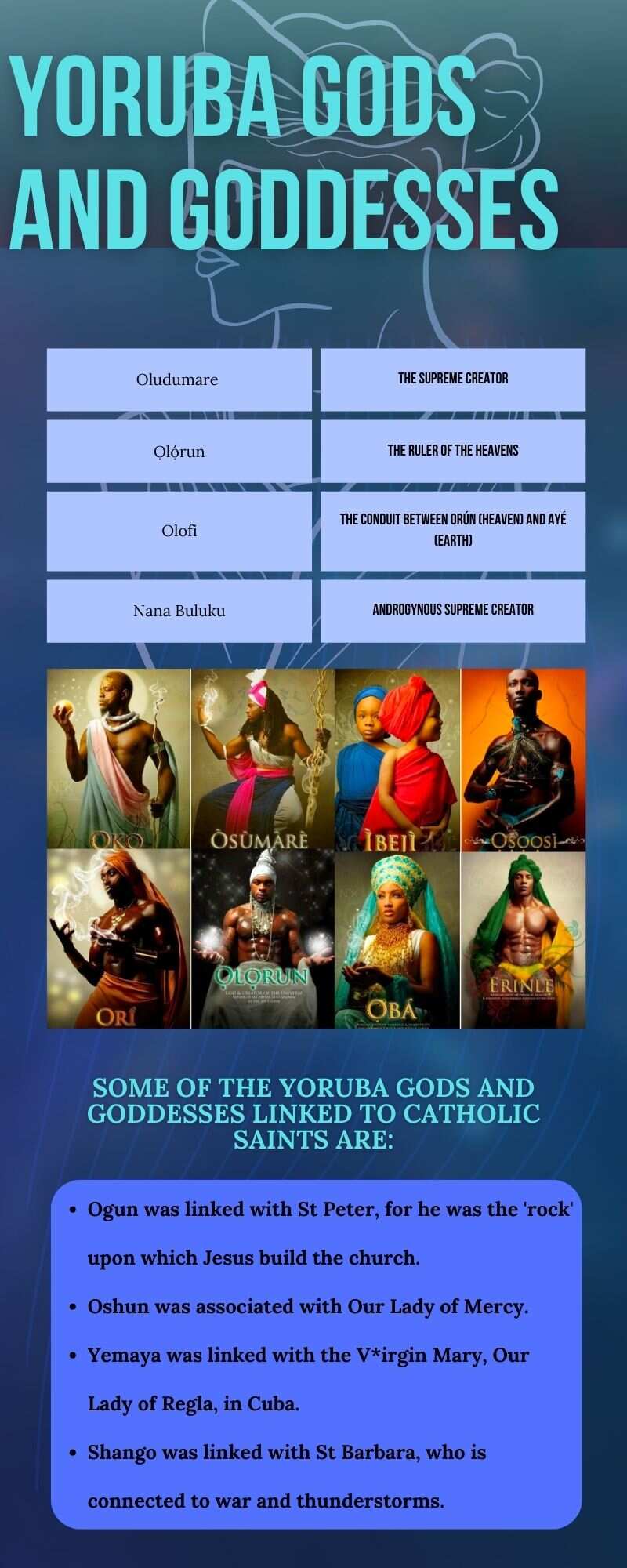
Source: UGC
The Yoruba are religious and liberal-minded people. A few are traditionalists, while most were assimilated into Christianity and Islam. Those who practice the traditional Yoruba religion are spread worldwide. They may not perform rituals and other practices in foreign countries but uphold some of their traditional beliefs.
The history of the Yoruba gods and goddesses
The history of the Yoruba religion started in the Stone Age. Agriculture from the Middle East highly influenced the people to develop the religion around 600 BC. Initially, they represented their gods using elements of nature like rivers, storms, mountains, and forests.
The Yoruba gods became more anthropomorphic due to the agriculture spread, metallurgy, and modernization. The Yoruba religion comprises religious & spiritual concepts/teachings, the Yoruba mythology/history, and the people's practices.
The Yoruba gods and goddesses
The Supreme Deity of the Yoruba is called Olódùmarè. He is a distant god believed to live in the sky and the mightiest of the four supreme deities in the Yoruba religion:
- Oludumare - the Supreme Creator;
- Ọlọ́run - the ruler of the Heavens;
- Olofi - the conduit between Orún (Heaven) and Ayé (Earth);
- Nana Buluku - androgynous Supreme Creator.
Protectors called Orishas lead and control everyday prayers because they are intercessors between the world of humanity and the divine/spiritual world. Below is the Yoruba gods' family tree:
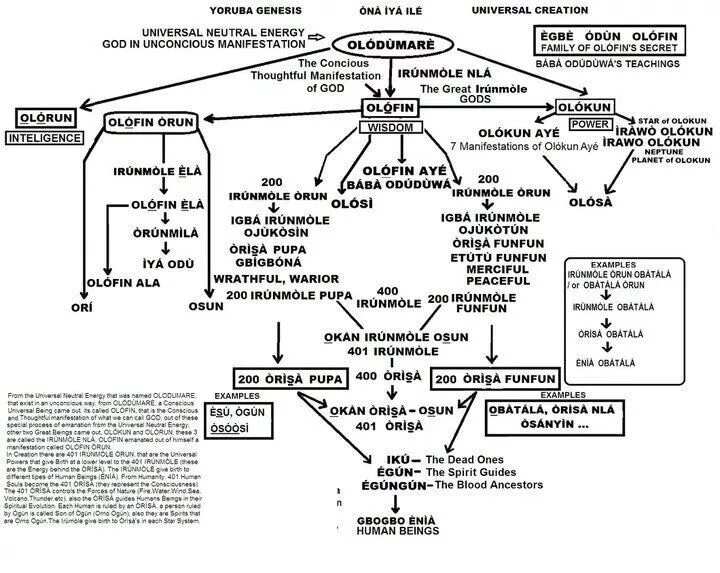
The Yoruba Orisha gods and goddesses
The Yoruba creation story has different versions. Each confirms the Yoruba religion has many Orishas but offer different explanations regarding how they came to exist. Each one represents specific ideas, objects or natural phenomena.
The Orishas attend religious celebrations by possessing believers and making them go into a trance. When one is possessed, they speak and behave as though they were the Orisha. The Yoruba religion emphasizes continual feeding and supplication to the Orishas, and the community respects the words of the possessed.
The Orishas' history based on the Yoruba creation story
Yorubas believe that Olodumare created the Orishas and threw powers of dominion into the air. Each caught powers that enabled them to participate in the creation and oversee different spheres of influence.
Olodumare created the Yoruba people through Oduduwa. Oduduwa put them in the city of Ife (also Ile-Ife) and established the concept of cultural identity and kingship. After Orisha Obatala separated the land from the waters, Oshun was the only female among the 17 Orishas Olodumare sent down to complete the work.
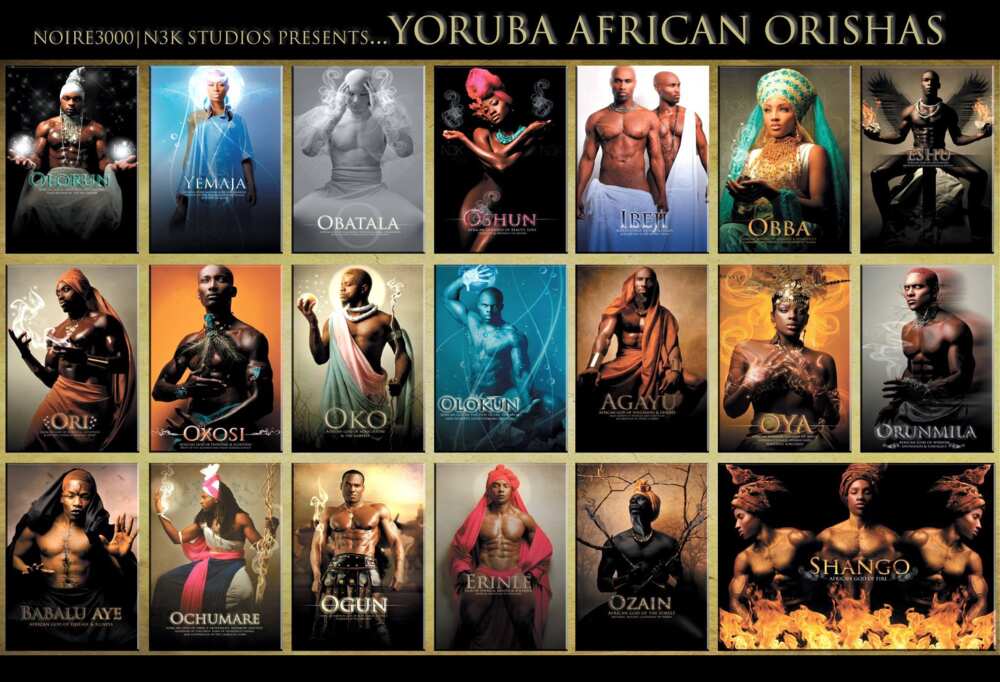
Source: Facebook
The male Orishas return to Olodumare to confess their failure. They told him that they ignored Oshun for being young and a woman. Olodumare sent them back to earth to apologize to Oshun because only she could complete the work.
Oshun finished the creation task and filled the earth with the gifts of beauty, fertility, love, and everything people needed to live. The Orishas give people Ashe/Ase (life) and Ayanmo (fate). One chooses their destiny before birth and reincarnates to achieve it in the next life.
Orishas omitted Esu (also called Eshu /Elegua; god's messenger who presides over doorways, crossroads, and change) from their plan to overthrow Olodumare and rule the world. Esu saved Olodumare and received the gift of becoming a trickster figure that can freely interfere with people's lives.
Olodumare stopped the rains. As a result, the plants died, and water bodies dried up. The Orishas wailed in repentance in vain. Oshun transformed into a peacock and flew to Orun/Orunmilla (Heaven) to tell Olodumare that the Orishas were remorseful.
She passed near the sun and lost most of her feathers. Oshun arrived at Orun, exhausted and ill. Olodumare released the rains, healed her, and appointed her as the only Orisha allowed to bring messages to heaven. The Orishas do not always cause trouble for Olodumare and are attentive to their responsibilities.
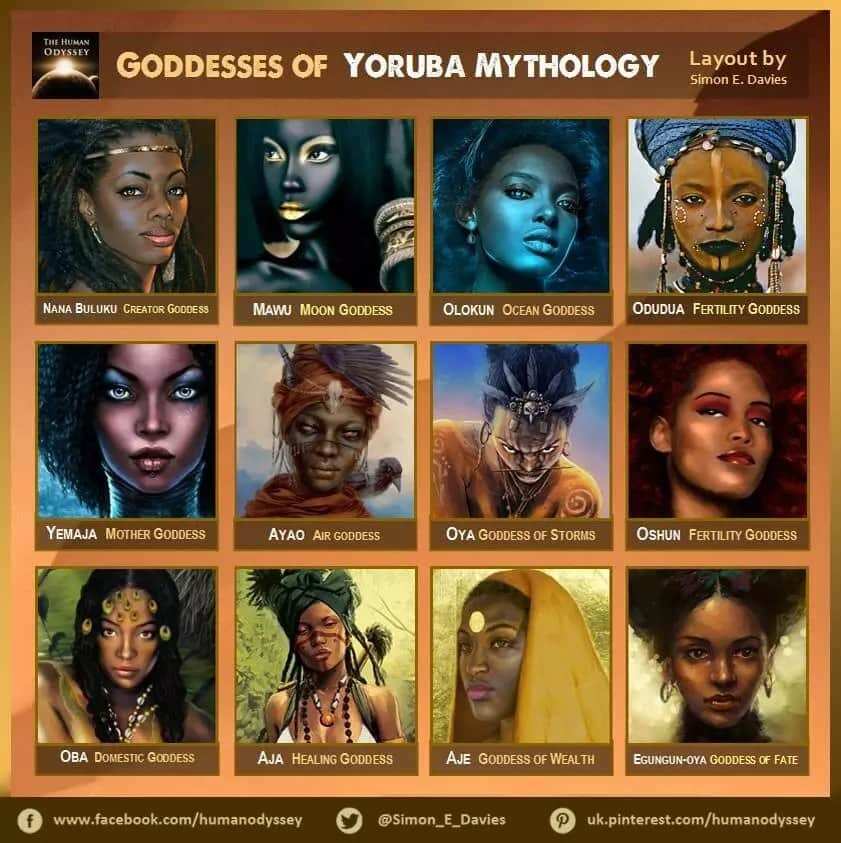
Source: UGC
The story of Orishas, according to the archaeological history
The archaeological evidence from the West African sites states that Orishas developed between 500-300 BCE. The Orishas travelled to America and the Caribbean during the Transatlantic Slave Trade, which saw many Yorubas being enslaved and assimilated into Catholicism.
Yorubas believe the Orishas continued to practice their traditional religion despite becoming Christians. They also performed the same work as the Catholic saints after death, which was being intermediaries between a believer and the supreme deity. Some of the Yoruba gods and goddesses linked to Catholic saints are:
- Ogun was linked with St Peter, for he was the 'rock' upon which Jesus build the church.
- Oshun was associated with Our Lady of Mercy.
- Yemaya was linked with the V*irgin Mary, Our Lady of Regla, in Cuba.
- Shango was linked with St Barbara, who is connected to war and thunderstorms.
List of Orishas from the Yoruba mythology
People invoke the Orishas in personal or communal rituals for enlightenment, spiritual strength, or assistance in daily challenges. Various sources state that there are at least 401 Orishas, and several are mentioned in Yoruba creation stories and archaeological history.
| Yoruba female Orishas | Roles and responsibilities |
| Aja | Orisha of the forest, the animals, and herbal healing. |
| Aje | Orisha of wealth. |
| Ayao | Orisha of the air |
| Egungun-oya | Orisha of divination |
| Mawu | Orisha of the sun and moon |
| Ọbà | Orisha of domesticity and marriage (Shango's first wife) |
| Olókun | Patron Orisha of the descendants of Africans carried away during the Atlantic Slave Trade. |
| Ọ̀ṣun/Oshun | Goddess of love, intimacy, fertility, beauty, wealth, and diplomacy (Shango's second wife). |
| Ọya | Goddess of the Niger River; the guardian of the dead(represents wind, lightning, fire, and magic) (Shango's third wife). |
| Yemọja/Yemaya | A mother goddess (the patron deity of women and the Ogun river). |
| Ọbà | Orisha of the River Oba, near Igbon. |
| Yoruba male Orishas | Roles and responsibilities |
| Aganjú | Orisha of volcanoes, the wilderness, and rivers. |
| Babalú Ayé | Orisha of the Earth (strongly associated with infectious diseases and healing). |
| Erinlẹ̀ | Orisha of medicine, healing, and comfort, physician to the gods. |
| Èṣù | Orisha of crossroads, duality, beginnings, travellers, fertility, and death (a trickster and a psychopomp). |
| Ibeji | A twin Orisha of vitality and youth. |
| Kokou | Orisha of war (a violent warrior). |
| Ọbàtálá | Creator of human bodies (represents light, spiritual purity, and moral uprightness) |
| Oduduwa | Orisha of humans |
| Ògún | Orisha of iron, fire, hunting, politics, and war. |
| Oko | Orisha of agriculture. |
| Osanyin | Orisha of the forest. |
| Oṣùmàrè | Orisha of rainbow serpent associated with creation and procreation. |
| Ọ̀ṣọ́ọ̀sì | Orisha of the hunt and forest. |
| Ṣàngó/Shango | Orisha of thunder, lightning, fire, virility, war, and foundations |
What is the name of the Yoruba gods?
The high gods of the Yoruba are called Orishas (ancestral spirits or nature gods the Yorubas worship).
How many gods do the Yoruba have?
There are at least 401 recognized Orishas in the Yoruba pantheon.
What are the 7 Orishas?
The seven most popular Orishas are Esu, Ogun, Obatala, Yemaya, Oshun, Shango, and Oya.
Who is the strongest Yoruba god?
Yoruba mythology states that Olodumare is the most powerful god. He created the Orishas to be mediators between himself and the people.
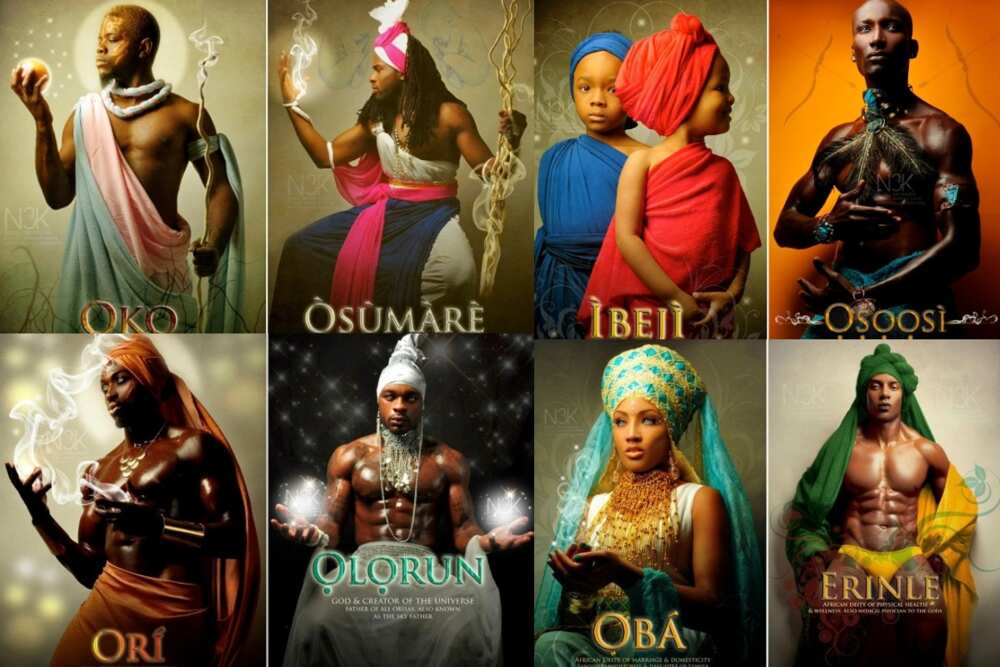
Source: UGC
Are there Yorubas in Cuba?
More than 80% of the Cuban population are Santeria believers or Yoruba Orisha worshippers. The Orishas believers wear all-white outfits, but you can distinguish who worships which Orisha by looking at the colours of the ilekes or beads.
Are Yoruba people in Brazil?
About 78% of Brazil's population are Yorubas. They were mainly captured from Oyo, Dahomey and Benin by the Portuguese and Brazilian slave traders and brought to Brazil.
Where are Yoruba originally from?
The Yoruba people occupy southwestern Nigeria. Their ancestral father, Oduduwa, migrated from the ancient city of Mecca in Saudi Arabia to Africa.
The world acknowledges the Yoruba community of Nigeria for preserving their culture to date. Yoruba gods and goddesses are worshipped in Nigeria, Cuba, and Brazil.
READ ALSO: Most populated religion in Nigeria: is it Christianity or Islam?
Legit.ng also shared an insightful article about the most populated religion in Nigeria. Traditional religion and Islam dominated Nigeria before the colonial era.
Christianity spread massively in the nineteenth century when the Europeans penetrated Nigeria. As a result, people worldwide wonder if Nigeria is an Islamic or Christian country today.
Source: Legit.ng







